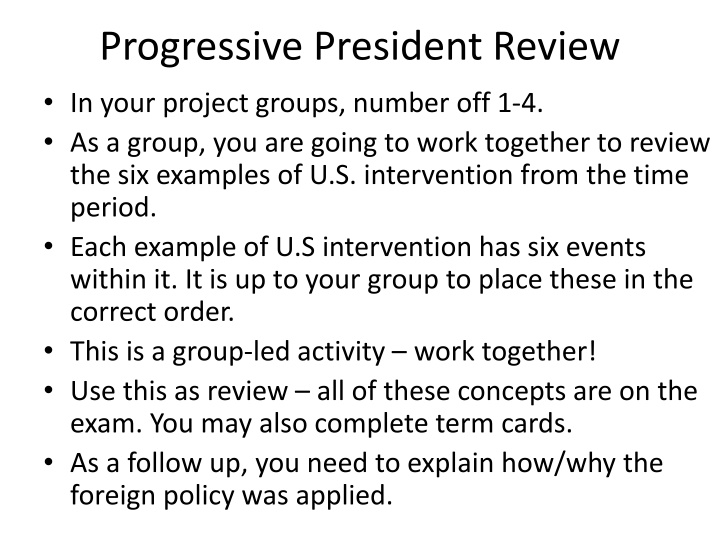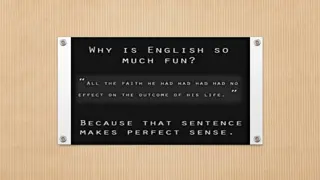U.S. Intervention Examples: Progressive President Reviews
Group-led activity to review six examples of U.S. intervention during a specific time period. Each intervention scenario involves a series of events that need to be placed in the correct order. Explore and understand the application of foreign policies in these historical contexts for exam review purposes. Additionally, explanations will be provided on how and why these foreign policies were applied.
Download Presentation

Please find below an Image/Link to download the presentation.
The content on the website is provided AS IS for your information and personal use only. It may not be sold, licensed, or shared on other websites without obtaining consent from the author.If you encounter any issues during the download, it is possible that the publisher has removed the file from their server.
You are allowed to download the files provided on this website for personal or commercial use, subject to the condition that they are used lawfully. All files are the property of their respective owners.
The content on the website is provided AS IS for your information and personal use only. It may not be sold, licensed, or shared on other websites without obtaining consent from the author.
E N D
Presentation Transcript
Progressive President Review In your project groups, number off 1-4. As a group, you are going to work together to review the six examples of U.S. intervention from the time period. Each example of U.S intervention has six events within it. It is up to your group to place these in the correct order. This is a group-led activity work together! Use this as review all of these concepts are on the exam. You may also complete term cards. As a follow up, you need to explain how/why the foreign policy was applied.
Venezuela is broke from Civil War and cannot afford to pay debts/loans to European nations.
Germany, Britain and Italy impose a naval blockade to take goods/money/loans by force!
Venezuela requests U.S. arbitration European countries refuse!
Roosevelt sent the U.S. navy to force an end to the blockade and push the countries into arbitration
In eventual arbitration, Roosevelt agrees to help pay Venezuela s debts = Roosevelt Corollary!
European countries withdrew their navies
To improve trade and travel, the U.S. agreed to sponsor the construction of a canal in Panama (cheaper than Nicaragua)
Roosevelt petitioned the Colombian government (who owned Panama) for a lease/purchase of land in order to build the canal
Colombia refused to allow U.S. construction of a canal in their territory
U.S. sent ships to sponsor a revolt in Panama. Also, gave money to Panamanian rebels and supplied them with weapons
Panama successfully revolted against Colombia and won their independence
Hay-Bunau-Varilla Treaty was signed. It created the Panama Canal Zone and allowed U.S. ownership/construction of the canal
After years of rebellions and internal conflict, Honduras was millions of dollars in debt to England (possible British military intervention?)
U.S. feared possible British intervention would threaten our economic interests in the banana industry
U.S. intervenes to help Honduras pay debts to England
Honduras government (under Davila) did NOT support U.S. involvement in the economy and tried to limit our influence
U.S. deploys troops in order to support Bonilla (Davila s rival!)
The U.S. continued to occupy the country several times between 1911-1925; led to some modernization reforms, but Honduras remained in debt
Jose Zelaya came to power through a military coup in 1893
As a result of several coups, Nicaragua was in debt to European countries. U.S. offered to help finance their debts, but Zelaya refuses!
Zelaya was angry with U.S. decision to build the canal in Panama because it would increase Nicaragua s economic competition with the U.S.
Zelaya sought Central American allies as trading partners to try and compete with the U.S. (he even petitioned for the construction of a separate canal in Nicaragua!)
The U.S. (under Secretary of State Knox) believed Nicaragua was intruding on American businesses and acting aggressively towards U.S. economic interests in Central America
U.S. helps finance a revolution and sends 2,700 marines in order to oust Zelaya Adolfo Diaz becomes president
In 1913, Huerta leads coup to oust the U.S.- backed president of Mexico, Madero
President Wilson refuses to recognize Huerta as president of Mexico (dictator!)
U.S. sent troops to Mexico and removed Huerta from power
President Wilson supported and recognized the new Mexican President, Carranza (people unhappy with U.S. interference)
Pancho Villa, with support of the Mexican populace, tried to overthrow Carranza
U.S. sent troops to Mexico ( again) to capture Villa, but failed! U.S. forced to withdrawal all troops.
Following their independence, the Dominican Republic (DR) was politically unstable and in a lot of debt. Despite these problems, they possessed great economic potential from sugar.
Wilson feared DRs vulnerability and worried other countries would occupy the country in order to take advantage of it s economic potential.
U.S. sends political and economic advisors to protect DR s independence and help with their debt.
U.S. established a provisional government to guide the transition to democracy. They also invest in economic modernization, including building of schools, roads and infrastructure.
Angry over U.S. involvement and imperialist desires, civilians lead a guerrilla movement to oust the U.S.
U.S. sends 24,000 troops but after the increased costs/burden of occupying the DR, combined with guerrilla attacks and American deaths, troops are withdrawn in 1924.




















